How We Make Money With Facebook Ads For Our Best-Performing Premium Store
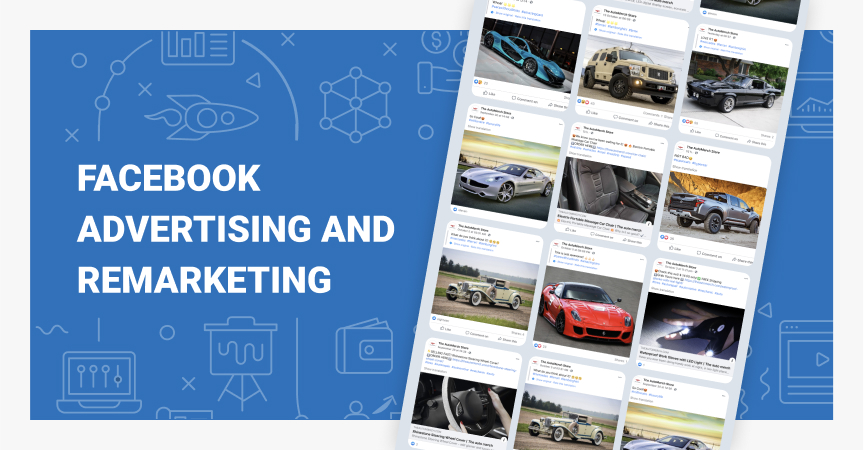
AliDropship’s Premium stores mostly make money with Facebook ads. In this article, you will find a detailed marketing strategy used by the team for our most successful Premium Store making over $500,000/month.
Most businesses promoting themselves online choose to advertise products or services on social media. As Facebook remains one of the most efficient platforms for advertising and selling products, it’s very important to learn how to make money from Facebook ads.
Here you will find a detailed, step-by-step guide on advertising and remarketing methods used by the AliDropship team to promote our best-performing dropshipping store and earn money by advertising on Facebook.
How to make money with Facebook ads: the advertising strategy
Promoting an online business on Facebook starts with setting up Facebook Pixel which tracks users’ activity. Read this article to learn how to install Facebook Pixel.
Step 1: Preparing a product and a product page
First, the team chooses a product for advertising. No matter how many goods you have on the site, you can’t promote all of them at once. It’ll be too expensive. When picking a product to advertise, the team behind the store uses the following criteria:
-
The product must be popular
Even if you have little to no ecommerce experience, there are more or less reliable ways to tell whether an item is popular on the market. We’ve discussed a great method of finding dropshipping goods earlier, but the idea is to check how many likes, comments and shares similar products get on social media or how many sales they make on AliExpress or Amazon.
-
The product must be affordable
Don’t forget that running Facebook ads and advertising on other platforms costs money. According to our own experience, the average cost of conversion on Facebook varies from $15 to $30. Since you’ll have to include this figure into the price, the product will get more expensive. So, make sure the final price won’t scare away potential customers.
-
The product must be useful and valuable to a buyer
The store we’re discussing today is built around practical car accessories for a reason. Such goods are much easier to advertise.
-
The original product on AliExpress must have suitable video materials
In most campaigns, our team uses video ads since this format shows much better results. It’s also important to find videos that demonstrate how this particular product can solve the buyer’s problem.
After that, the team prepares the corresponding product page. They add customer reviews with photos of the item, write a description with GIFs (if possible), improve the page’s loading speed, etc. The idea is to make a perfect product page that won’t disappoint visitors who come after seeing the ads.
Step 2: Creating video posts
Next, the team creates a number of video posts and publishes them on the store’s page. We usually make 7 video variations and 3 text and thumbnail variations for each of them. As a result, we end up with 21 post variations in total.
Why so many? At this moment, we don’t know which of them will attract more attention, which is why we need to test them first. Besides, we are not going to turn off this campaign completely. As it keeps running, the posts will get more likes, comments and shares, thus becoming more noticeable in the feed and getting more reviews.
We use posts instead of standard ads because Facebook users tend to click more often on ad posts with a high number of likes and comments. Everything these posts earn during this PPE campaign will work for our conversion campaigns later.
Step 3: Launching a PPE campaign
Now the team launches a Page Post Engagement campaign to promote these posts. Such campaigns cost cheaper than conversion campaigns and are great for testing ads. We set the budget to $10-15 for each ad (post).
The budget may seem like too large, but as you will see, we are going to turn off many of these ads within less than 24 hours. So Facebook won’t have enough time to spend all this sum.
As for audience targeting, the team uses the following settings:
- Countries: The US (as of now, the team focuses on the US only, but generally we also advertise in the UK, Canada and Australia)
- Language: English
- Placement: Automatic
At this stage, you can ignore target audience demographics unless you’re absolutely sure about your customer’s age and gender. For some product types such parameters are obvious even without any tests or analyses. But we usually specify demographics later when we collect more data from this and other campaigns.
Since PPE campaigns raise engagement, your posts are going to get lots of comments. Make sure you reply to all of them (or at least as much as you can) and answer personal messages as well. It goes to all your campaigns (not only PPEs). Don’t forget that social media are places where users communicate!
Step 4: Testing video posts
The team usually launches the PPE campaign at midnight and checks the results in the morning. The choice of time depends on when your Facebook Ad Manager starts working.
We analyze the posts’ Click Through Rate, their Average Play Time and Cost Per 1,000 Impressions and shut off 1 or 2 worst-performing ads from each group of 3 variations.
I mean those text and thumbnail variations we created for each of the 7 videos. So after this we should have 1 or 2 variations left.
After that the team runs the campaign till evening and turns off every post that didn’t perform well enough. We end up with a maximum of 3 or 4 best-performing ads no matter what variations they are.
Now that we have winning video posts, it’s time to start a Facebook ad campaign aimed at conversions. But as I mentioned before, the team keeps the PPE campaign running so that the posts could keep raising their engagement level. Only now we increase the budget to $15-20 per each post to gather data as well as likes, shares and comments faster.
It’ll help us make money with Facebook ads later.
Step 5: Launching a conversion campaign
The team uses 1-3 best-performing ads to launch a conversion campaign. This one is going to lead Facebook users to our product page in order to sell them the item being advertised. Still, at this point we don’t expect a lot of sales and want to test the audience by interests.
The team uses Facebook interests for targeting. We discussed how to find and test Facebook interests for targeting in one of our previous articles.
Each conversion campaign initially targets at least 5 interests. Later, we can add more interests to test them. So, the team creates a corresponding number of ad sets, with each containing at least one video ad and targeted at one interest. We choose countries to target based on the destinations’ CTR in our PPE campaign, but targeting the US is a must.
The team sets the budget for each ad set to half of the product’s price, but not less than $10. For example, if the product costs $40 in the store, the daily budget of each ad set should be $20.
You can set a different budget for your PPE and conversion campaigns. Just remember that you can’t make money with Facebook ads unless you pay for them. Campaigns with a small budget collect data slowly while a big budget boosts the tempo. So, if you want to get results faster, feel free to pay more. These are just average numbers.
Just like we do with our Page Post Engagement campaign, we launch the first conversion campaigns at midnight.
In the morning, the team turns off the ads and ad sets that show poor results. As for the remaining ad sets, we keep them running for several days even if their performance doesn’t seem to be so good. Such campaigns (which we use for testing Facebook interests) often take up to 7 days before you get reliable results. Of course, the team monitors their performance.
How to earn money from Facebook ads: a few tips on checking their performance
Ideally, you should test your ad sets for at least 3 days. Making conclusions based on shorter periods is often premature because sales always come in peaks. Sometimes you’re simply having bad days.
If an ad set behaves clearly worse than others during all this period, there’s no doubt you should either turn it off or experiment with ads within the set. Sometimes one and the same ad works great with one audience but doesn’t work at all with another one.
Audiences and ads also tend to “fade away”, become less effective as time passes. After a while, they simply stop converting users as well as they used to. In this case, the team changes the ads’ texts and/or featured images/thumbnails. Ideally, you should edit the existing creative or make a completely new ad.
Step 6: Collecting demographic data
The conversion campaign keeps running. At this stage, we leave it alone for a while. Two or three days after we launched our PPE campaign, it’s time to check the demographic data both our campaigns have collected so far.
To see these data, we break-down the audiences of all the existing campaigns including PPE into age and gender segments.
The team uses the new data to optimize the targeting settings of the existing campaigns – both the PPE and conversion campaigns. We simply duplicate the existing ad sets and use the new targeting settings.
Sometimes, when the initial targeting happens to be completely wrong, we turn off the original ad sets. If not, they keep running along with the duplicated versions.
Step 7: Creating a lookalike audience
Now it’s time to get back to our conversion campaign that tests Facebook interests. In order to make money with Facebook ads, we are going to create custom audiences based on these results and use them to generate lookalikes.
First, the team creates a custom audience consisting of users who watched 95% of the video ads over the last 7 days. These data come from all the videos that advertise one particular product. To make this work, we need at least 2,000 users. Depending on your budget, 3-7 days is usually enough to collect this many.
If the video is very long (about 40 seconds or longer), it’s Ok to select users who watched at least 75% of the video. People usually don’t watch long files till the end.
Now that we have more than 2,000 users who seem interested in the product, we create a lookalike Facebook audience and break it down into six audience size segments: 1%, 1-2%, 2-3%, 3-4%, 4-5% and 5-6%.
Step 8: Launching a conversion campaign targeted at the lookalike audience
Now the team uses this lookalike audience to create a new conversion campaign. We create one ad set per each size segment I mentioned above. The budget is set to half of the product’s price per ad set just like previously.
The team places not one but three or even four best-performing video posts from the PPE campaign in each ad set. By this time, they usually gather quite a number of likes and comments.
The campaign usually runs for 2-3 days before we check the results and turn off the worst-performing ads. When the campaign gets at least 20 add-to-carts, checkouts or purchases, the team moves on to creating another range of custom and lookalike audiences.
Step 9: Creating new lookalike audiences
As our campaigns collect data, we can use it to create new lookalike audiences for another conversion campaign.
First, the team starts making custom audiences consisting of the following categories of users (these are the abbreviations the team uses to name these audience segments):
- 95% VV7 (95% video views, 7 days): users who watched 95% of our video posts over the last 7 days;
- 75% VV7 (75% video views, 7 days): users who watched 75% of our video posts over the last 7 days; used for long videos;
- WV 7 (website visitors, 7 days): users who visited the website over the last 7 days no matter how long they stayed;
- VC 7 (view content, 7 days): users who visited the website over the last 7 days; it’s different from the previous segment in that these users spent more time there;
- VTS 25/10/5 7 (visitors by time spent, top 25, 7 days): top 25/10/5 users who stayed on the site longer than anyone else over the last 7 days;
- ATC 7 (add to cart, 7 days): site visitors who added the product to the shopping cart over the last 7 days:
- IC 7 (initiate checkout, 7 days): site visitors who initiated the checkout process over the last 7 days;
- PUR 7 (purchase, 7 days): site visitors who purchase the product over the last 7 days.
To generate a really useful lookalike audience, Facebook needs examples. The larger your customer audience the better.
For lookalikes based on “video views”, it needs at least 2,000 users and at least 200 for “website visitors” and “view content”. “Add-to-carts”, “initiate checkout” and “purchases” require at least 20 users, but it’s best to have about 50. Otherwise, Facebook will have too little information for finding similar users.
The time period is also important. While it’s Ok to set it to 7 days for most of these audiences, ATC, IC and PUR require a different approach.
At first, we recommend creating these three audiences based on users who performed the corresponding actions over the last 30 days instead of 7. Only after they start generating at least 100 purchases, add-to-carts and checkouts within a 7 days period, we change the period to 7 days.
As the campaigns keep gathering more users, we create these audiences one by one.
Step 10: Creating value-based audiences
It’s also a good idea to experiment with value-based lookalike audiences to make money with Facebook ads. Let me explain what they are in simple words.
Facebook generates standard lookalikes based on a custom audience. It analyzes their behavior and interests to find people who act in a similar manner.
When Facebook generates value-based audiences, it also takes into account how much money these people tend to spend. In other words, it tries to find users who will most likely spend more money on your store.
Such audiences can be based on custom audiences that consist of users who viewed the site’s product pages, added something to the shopping cart, initiated checkouts and purchased something. Facebook algorithm analyzes the prices of the products they viewed, added to the cart, tried to purchase or purchased and looks for people who are ready to spend similar sums.
Now the team creates value-based lookalikes (based on the custom audiences I just mentioned) and breaks them down into size segments like we did with our previous lookalike audience.
Step 11: Launching and running a SANDBOX conversion campaign to make money with Facebook ads
The team launches another conversion campaign targeted at the audiences I have listed above. The team uses one campaign, but if you find it more comfortable, you can launch several campaigns.
We call this the SANDBOX campaign because it’s going to be our main testing arena.
Each ad set is targeted at one size segment of one of the listed lookalike audiences. The budget is set to half of the product’s price in the store but not less than $10 per each ad set. Also, the team excludes the custom audience users who have already purchased the product over the last 180 days from each ad set.
Next, the final testing begins. We give the ad sets at least two days before making any decisions.
Any ad sets in the SANDBOX campaign that perform badly can be turned off. If it performs well, the team duplicates the ad set into a new campaign and doubles the budget. If this new ad set performs well, we duplicate it and increase the budget again.
For example, if the budget for an ad set in the SANDBOX campaign was set to $15, we duplicate it into a new campaign with the budget set to $30. If everything is good, we make another copy with a budget of $60 and so on.
Why duplicate the ad sets each time they perform well instead of just raising their budgets? There’s an ideal budget for each ad set which generates the maximum ROAS. You simply need to find it.
But each time you change the budget, Facebook has to start over, so to speak. On the other hand, if you duplicate the ad set, your “previous” ad set keeps running. If the copy performs worse than it, you simply turn it off in one click.
How to make money with Facebook ads: the remarketing strategy
As you can see, the advertising strategy we use starts with targeting huge audiences of random people. It lets Facebook define which audiences convert better on its own, which is really useful for broad niches we use in our Premium Stores.
As we test different settings and ads, we collect more data and narrow down the audience. Facebook also manages to find people more interested in our products, thus improving the quality of its audiences. As a result, we target people who are more likely to buy.
The more money you spend on advertising, the faster you can collect the data and the more people will become actual buyers.
The warm part of this audience who didn’t purchase anything can be retargeted with remarketing campaigns. And that’s another way to make money with Facebook ads.
Remarketing is another important part of our promotion strategy. While the standard ads are targeted at cold audiences, unfamiliar with our store, remarketing targets people who have already interacted with the website or our ads. This makes remarketing much more effective.
Here is the strategy the team uses to retarget audiences.
Step 1: Creating custom audiences
The work usually begins 7 days after launching the initial PPE campaign. By this time, we should have enough users who have interacted with the ads or the website to start remarketing.
The team creates two custom audiences from all users who got into our previous campaigns.
The first audience are Facebook users who watched 95% of the video posts over the last 7 days. Remember: if the video is about 40 seconds long, it’s Ok to set the limit to 75%.
The second audience are users who visited the product page (“viewed content”).
Step 2: Launching a remarketing campaign and making exclusions
When the audiences are ready, the team makes another set of ads. For users who watched 75-95% of our previous video posts (“video views”), we can use the same videos. But we also create new ones designed specifically for retargeting. Sometimes the team also adds coupons or photo reviews from customers in remarketing ads.
In addition, our team creates image ads. We recommend adding the images in 3 formats – vertical, horizontal and square for each group of placements. We also make up to 5 text variations for each ad and let Facebook define which one performs better.
Then the team launches a conversion campaign and sets up exclusions.
For “video viewers”, we exclude the users who visited the product page (“viewed content”) and the ones who have already purchased the product. For “content viewers”, we exclude only the ones who have purchased the product.
In theory, you don’t have to exclude “buyers” from the first audience because people can’t buy anything unless they visit your store. Excluding “content views” should be enough. However, sometimes Facebook doesn’t mark buyers as site visitors, and they get into the audience. That’s why we recommend excluding buyers “manually” – just in case.
The team creates one ad set per each of the two audiences. As for the overall remarketing budget, we recommend setting it to 10-20% of the budget you spend on advertising. For example, if you spend $1,000 on advertising, set your remarketing budget to $100-200. Thus, the more you spend on advertising the more you should spend on remarketing.
If you’re not sure how to split the money between the two remarketing audiences, use Facebook’s Campaign Budget Optimization. This function sets the budget for the whole campaign and allows the algorithm to make the decisions based on how the ad sets perform.
If you want to do it manually, set the initial budget to $10-15 per each ad set. As the budget of other campaigns keeps growing, you should also spend more on remarketing.
Step 3: Start making money with Facebook remarketing ads and monitor the campaign’s performance
After the campaign is launched, the team monitors the “Frequency” metrics. It reflects how often a user sees your remarketing ads. It should be between 2.5 and 5 as long as it brings sales. We also monitor Click Through Rate and Cost Per Click.
If a creative or ad set performs well, the team raises its budget by 50% of the current value at a time until its revenue stops growing. If the ad set’s performance starts to get worse, we cut the budget.
In this case or if a creative or ad set performs not well enough from the very beginning, the team cuts the budgets by 33% of the current value at a time. If the performance doesn’t get better, we keep decreasing the budget until we have to turn off the ad set completely and try something new. The team usually shuts off the creatives with the lowest CTR and highest Cost Per Click.
Clicks here are more expensive compared to our previous campaigns, but don’t worry. Click Through Rates and Return On Advertising Spend (ROAS) in remarketing campaigns are always higher, so you can make money with Facebook ads despite the cost of remarketing.
Note that you shouldn’t change the ad sets’ budget more often than every two days as Facebook needs time to complete its learning phase and optimize its performance.
Since retargeting people who have interacted with your store is more efficient than targeting people unfamiliar with it, the remarketing campaign keeps running all the time. However, we still experiment with new creatives and audiences with different time periods.
For example, if one of your initial ad sets was targeted at people who watched 95% of the video ad over the last 7 days, you can create an ad set targeted at the same segment but collected over the last 14 days. We also recommend launching ad sets targeted at the same audience collected over the last 30 days as soon as enough time passes. Also, don’t forget to exclude all previous segments from new audiences.
The team always uses new ad creatives for these new ad sets.
This is the basic method used by our team for Facebook advertising. However, there are more nuances and secrets, which you can learn from AliDropship’s free bonus course available after purchasing any Premium Dropshipping Store as well as from upcoming blog articles and YouTube videos. So stay tuned!
Having these insights on how to make money with Facebook ads, you can easily start your own successful dropshipping business by purchasing a copy of any Premium Store and putting your marketing knowledge into practice!

tutorials and special offers from AliDropship
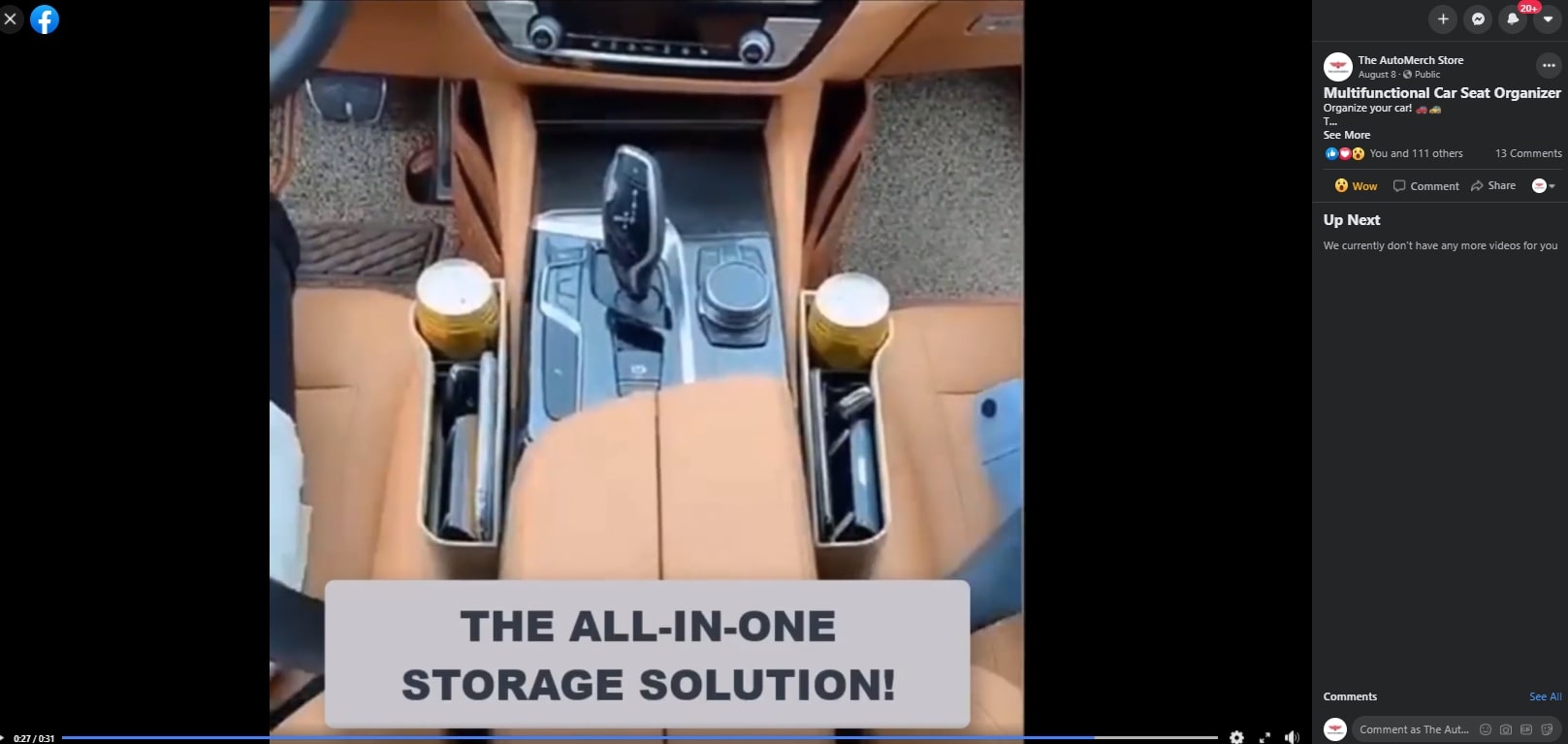
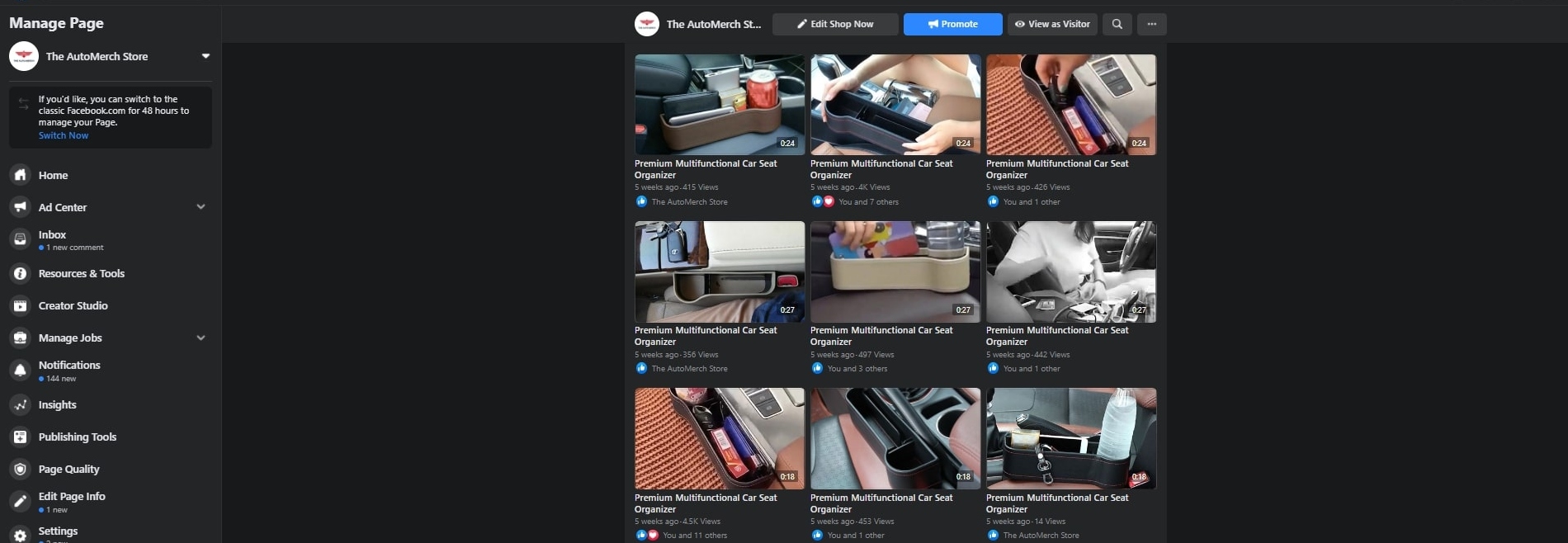
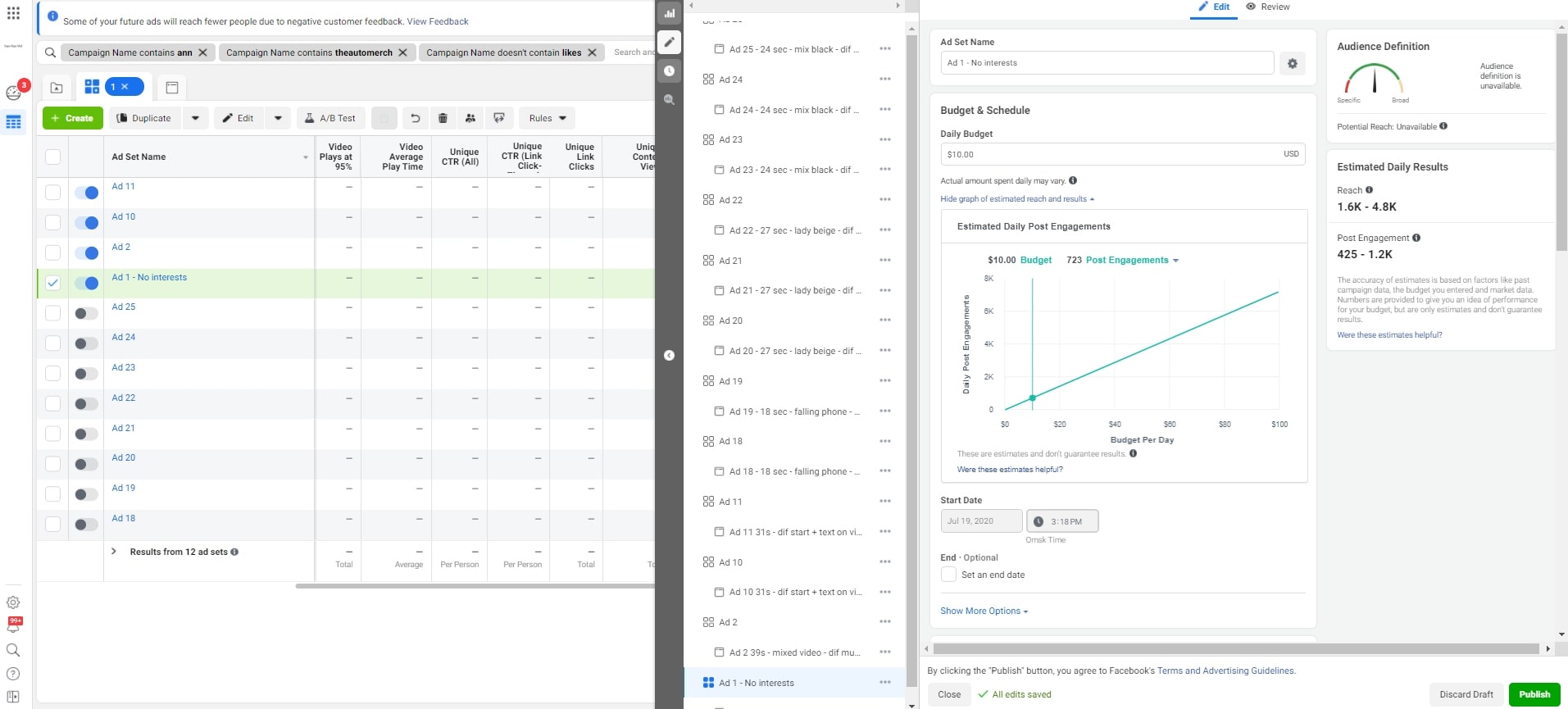




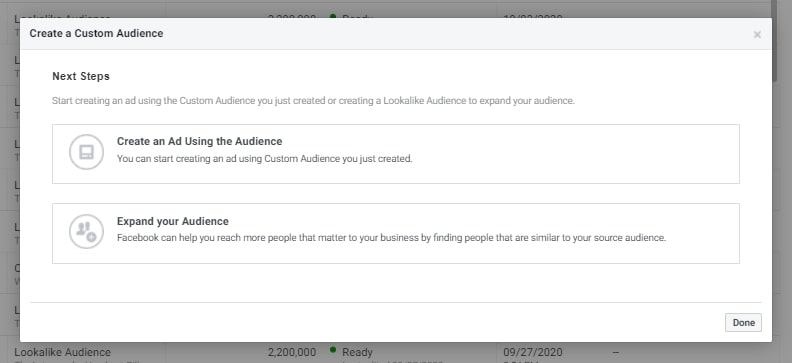
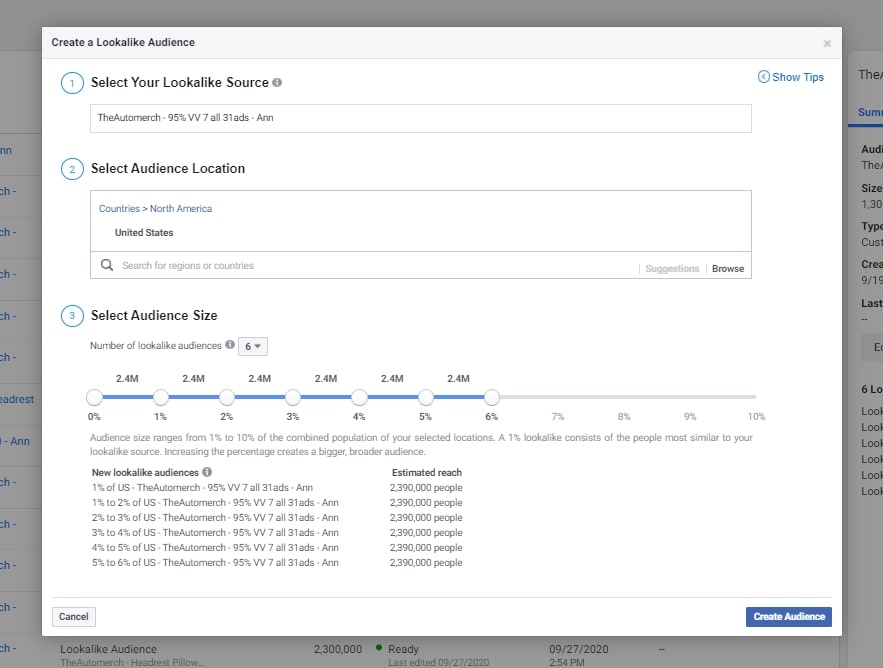
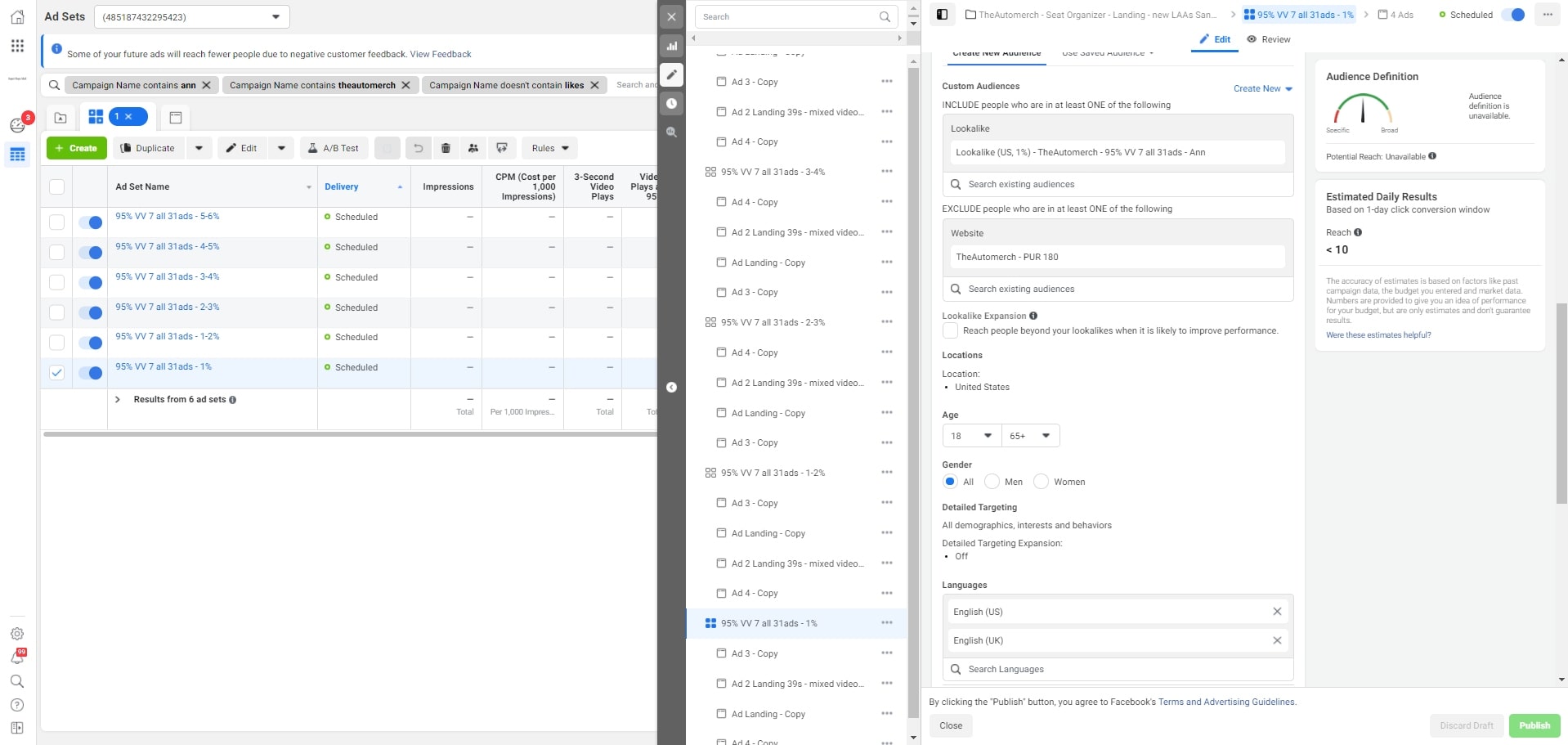

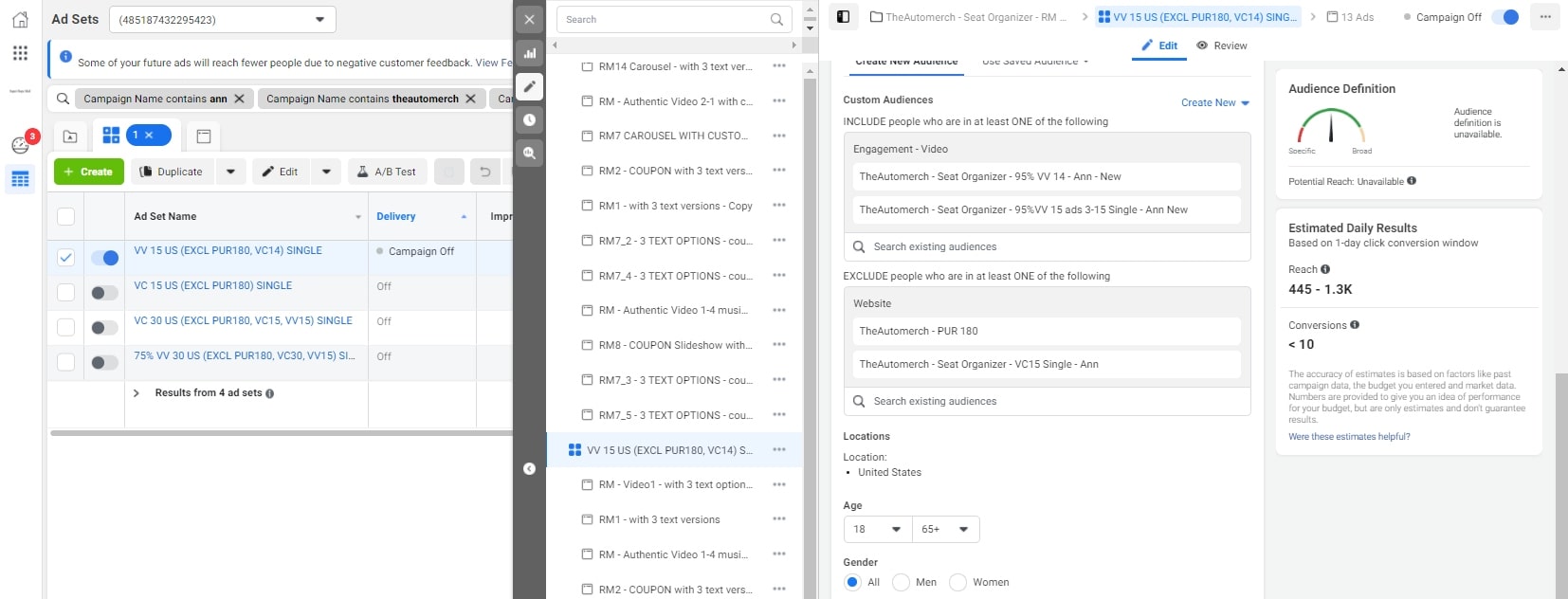
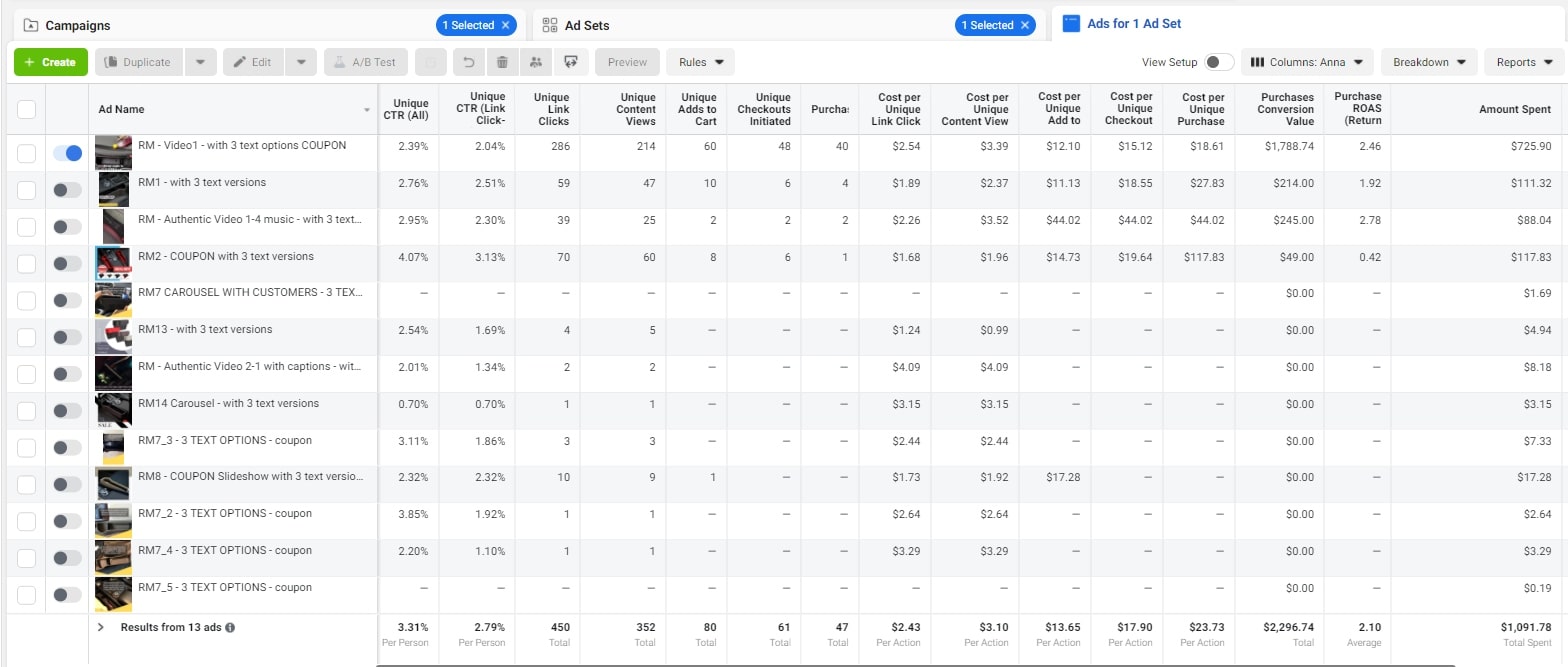




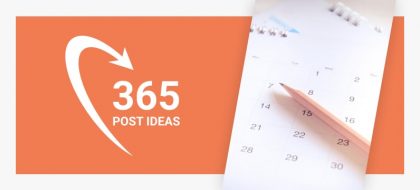
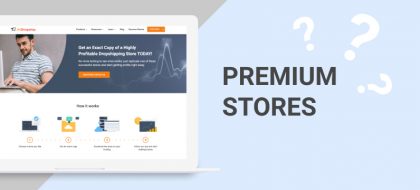








Ths articl is powerful
Thank you, Valery.
There’s some question in my mind Timur, I hope You are willing to help 🙂
If I make PPE then set target audience to UK, why the meter of audience is broad? not same as your screenshot while show define audience?
Don’t worry about it. Actually, when you create a PPE campaign, its audience is usually extremely broad, which normal. After all, the campaign’s goal is to help you understand who your potential buyers are. So, in most cases, audiences are going to be broad.
Okay then, I follow Your Step until conversion campaign with several ads set, but why after 3 days the conversion ads can not passed the learning? Then facebook recommended to raise the budget or combine with another adset? what should i do?
Facebook usually needs at least 50 conversions. That’s Facebook’s learning phase. In most cases, it means the system hasn’t spent enough money. I recommend simply waiting until the learning phase is over even if takes more than you expected (or longer than our team usually has to wait).
Thanks for the answer Timur
Now my campaign ate a lot of budget, I’ve received only 4 order so far
I’m on my way at step no. 9 for 5 days, I’ve tried to make one adset for each lookalike audience but no purchase, then I make new adset and combine all lookalike audience VC,VTS,IC,ATC for 3 days it’s make several abandoned chart but still no result in purchase
Please, I need Your correction, where step i was wrong?
Good Day Timur, the team usually launches the PPE campaign at midnight and checks the results in the morning. Please advise on what time frame this is? GMT-5??
Hello, Dwain. When you launch campaigns, you want to run them when your target audience is active. Of course, I didn’t mean you always have to launch campaigns before going to bed. We, for example, have to deal with a different time zone. I just wanted to show you that one can get the first results in less than 24 hours. So, if you live in America and target America, you should probably launch a campaign in the morning and check the result in late afternoon.
Hello, Vincentius. I couldn’t ‘reply’ to your message, so I’ll start another one here.
As far as I can tell, it’s definitely too early for VTS, IC, and ATC. Also, we recombine and scale only those ads which show good purchase cost. If an ad converts users into buyers but costs more than the product, it’s a bad ad. Are you sure your ads perform well? It’s really difficult to tell what is wrong with your campaign without seeing it, but it seems that you’re hurrying too much.
Remember, if an ad didn’t perform well on a particular phase or you didn’t collect enough users in your audience, there’s no point to move on to the next step with this ad or audience.
Hola Timur, I’ve been waiting for your answer for long day and didn’t realize that was appearing down here, please help me explain the following questions
1. Let’s says that my ads didn’t perform well, then what metrics should I focused on?
2. If cost per addto cart or cost per initiate checkout is not more than the product, should I still wait? But it ate my budget alot and no purchase because facebook cost me for impression
3. If there is no purchase for 7 days could conversion aimed to purchase? facebook warning me that the campaign maybe got no result when i set the adset
Hi, Vincentius. Welcome back. The team and I looked at your store, and we’ve concluded that the problem may be in the site. Although I’d still take a look at your FB campaign as well. Anyway, one of our managers agreed to contact you to explain what the problem could be and what you can do about it.
Hi Timur, It’s been several days but there’s no manager contacted me, please do me a fatvor with this. I make several campaign, try another audience, back to 95%vv but there’s no purchase still
What should I do? Start again with PPE with this product? or change the product and start another campaign?
Thankyou for reaching out Timur, I’m suprized and worry what problem with my site? But i’ll be wait a manager to contact me
Hi, Vincentius.
Do your ads successfully lead Facebook users to your site? I mean, do people convert into site visitors (not buyers)? Because if they do come to your site, then the ads work fine (at least more or less fine). But if they always leave without buyng anything, this could mean certain issues with the site itself. Particularly with loading speed.
Also, are you sure you get enough audience before creating lookalikes? Because if there’s not enough users (see the instructions in the article), then Facebook will not be able to make a good lookalike and your efforts will go for nothing.
Yes I’ve seen significant visitor to my website Timur, many of them leave without buying, some of them making view content, some of them making abandoned chart, less of them making purchase (I made 7 purchase $182 but overal campaign cost me $845)
Yes I follow your guide before making audience more than 200 content view, more than 20 add to chart, more than 20 while making Initiate Checkout
Just like I suspected. Since people do visit your site, it means your Facebook campaign is doing more or less fine. But you lose buyers at the last step – when they should buy the product. So, the problem is most likely in the site. Could be loading speed (the hosting you’re using isn’t the best option to be honest); could be trust issues, or shipping options, or delivery time. On one of your product pages, there’s a weird image. I clicked on it, and it moved me directly to AliExpress! That’s definitely not a good sign.
I suggest that you stop your campaigns until you get these issues resolved. I asked the team to hurry up and contact you sooner.
Thanks alot for correction Timur I will fix this (On one of your product pages, there’s a weird image. I clicked on it, and it moved me directly to AliExpress!)
But if the problem is on my website, should not I get a lot of link click and high CTR?
You mean CTR with your ads? What’s your CTR on each step?
I mean link click and CTR in fb ads Timur, if the number high but purchase result is low that maybe my website is bad, am i right?
In my case link click and CTR is low
Anyway I have installed Image SEO Image optimizer plugin which recommended by Alidropship to faster loading pages
Hosting matters too. As well as the number of products and other aspects.
Yes, Vincentius, you are right.
If the CTR of your video ads is low (you test video ads at step 4), it means these ads are less efficient than you need. They may still work and convert customers but the income may be not enough to cover the expenses. Besides, don’t forget that even good ads tend to ‘fade away’ in time. If you see that the CTR of your ads is low, then you may want to start over with new ads. Each of the steps in this strategy will work only if you succeeded in the previous step. But if you continue with low-quality ads, the result can be much poorer than you expected.
So Conclusion of my case, please correct me if i am wrong
My website load speed maybe doesn’t good enough, maybe as not best as hosting by alidropship, but fair enough to convert facebook campaign into buyer, my problem is the video ads or campaign in early step (maybe PPE or conversion video view) didn’t perform well but i was too hurry to move to next step?
Please give me correction Timur
That’s right, Vincentius. I’d say it could also be your target audience, but I suppose you didn’t get to this stage yet.
Thankyou for correction Timur,
So if I want to start new campaign with this same product but with less budget, what am i should to do?
campaign under $5 or shrink the audience? for example people living in Los Angeles not United States?
To be honest, I don’t see how decreasing your budget could help you sell more. With lower budgets, Facebook’s algorithms take longer to collect data. The precision of this data suffers too. Same goes for shrinking the audience, especially based on location. I mean don’t expect better results without spending the minimum indicated in the strategy above. But of course, spending more isn’t smart either.
I recommend, first of all, solving the issues with your site. There’s no point in spending hundreds on advertising if your customers run away from your site after they get there. Improve speed, make product images simpler – one good-looking and informative image is enough. Right now your site looks like a comics book – really hard to focus on particular products. Many goods don’t have adequate descriptions or have no customer reviews at all. Also, maybe it’s not a good idea to offer to Americans delivery from China and Russia. Some prices look suspicious considering the original price claimed by you. It looks like you’re selling some stuff for 25-30% of the original price.
And pay special attention to the page of the product you’re going to advertise. Check this article: https://alidropship.com/top-7-improvements-product-page-increase-conversion-rate/
Next, think about creating better ads. This article may help (last section): https://alidropship.com/tips-on-making-facebook-video-ads/
Make a few video ads and start over. Move on to the next step ONLY if you’re happy with the parameters of the corresponding campaign. So, if the CTR is too low, don’t waste money on the next phase: you will probably fail anyway. Succeed in the first step, then move on to the next.
Woow! I am very grateful how You give me so much advice Timur it is a honor
Okay I must take in depth my site first, i’ve been read all these article You mention above before, and so much more article by You. Thankyou so much Timur, may God bless You!
Good luck!
What I want to ask is, is the price of the product constant throughout the process?
There is no promotion, or it is replaced with a landing page and sold at a discount
Usually, if the original price for the product changes and so do the discounts you’re promoting, you have to create a new campaign (or at least considerably change the current one) because you need new creatives. Besides, even successful ads tend to generate fewer and fewer sales as time passes, so we have to change them with new creatives anyway.
How much do you spend o facebook for these results
I don’t think we still have those numbers. Usually, such Facebook campaigns cost from a few hundred to a few thousand dollars depending on how successful the initial tests are. It is the first stages of any campaign that eat up most of your budget – because at these stages, you earn very little and focus on testing instead. On the other hand, you don’t have to spend as much on advertising as we do. It’s just that the more you spend the faster your campaigns show results (positive or negative).